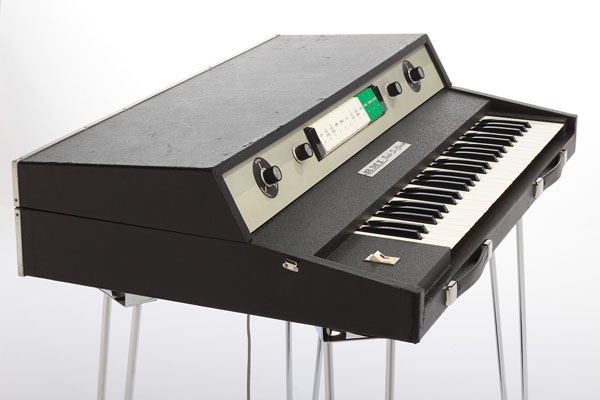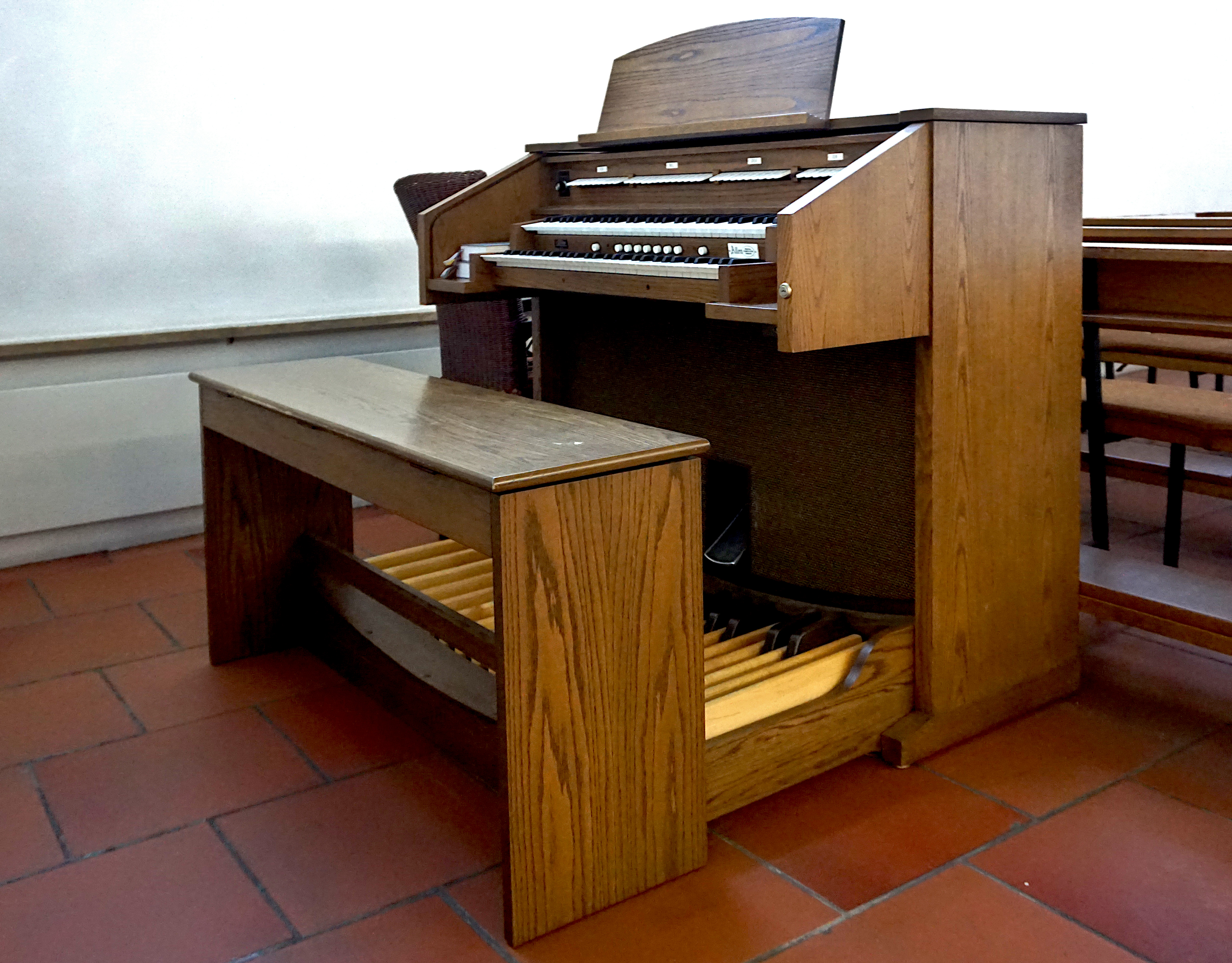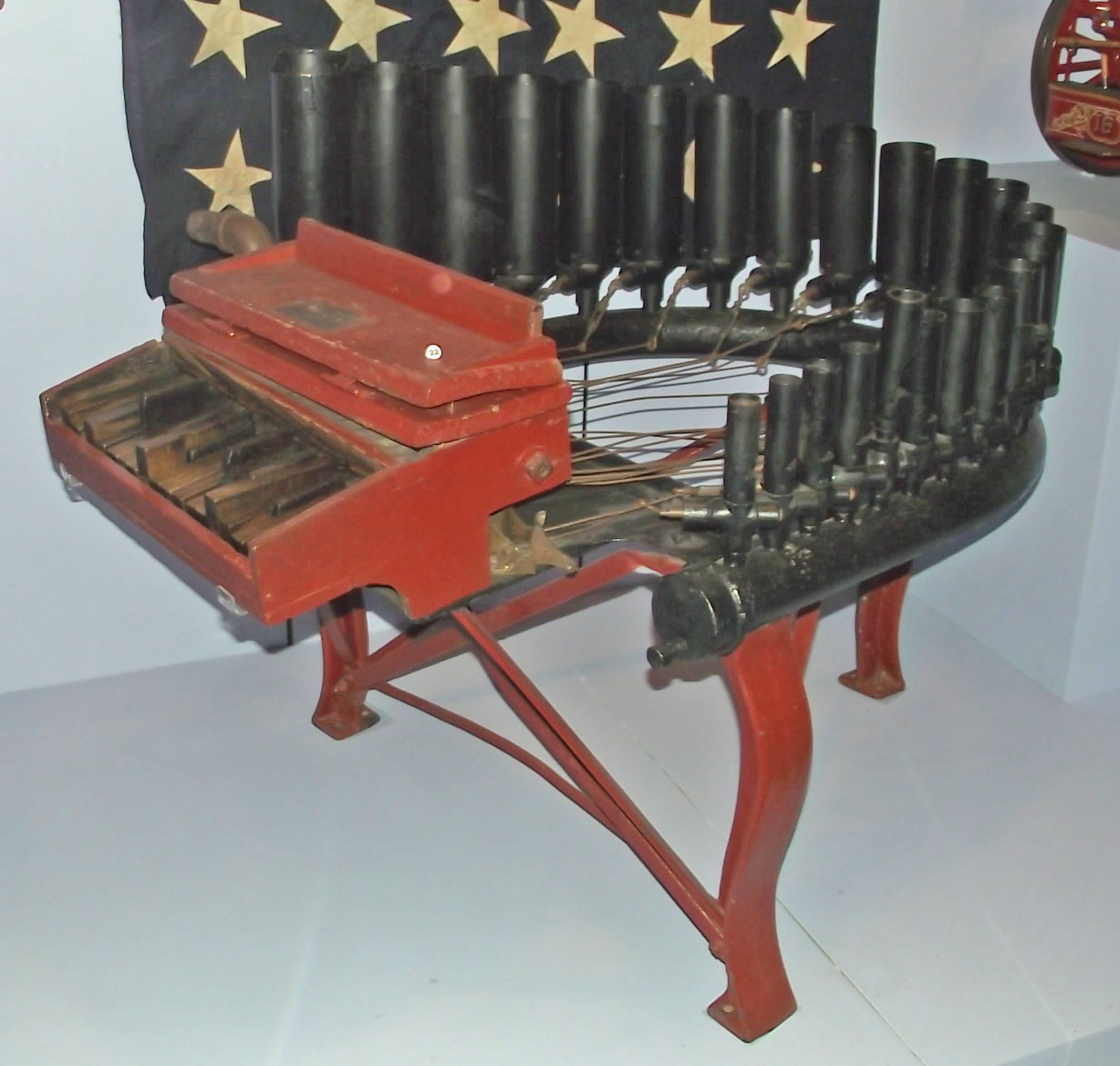|
Rocksichord
Rocky Mount Instruments (RMI) was a subsidiary of the Allen Organ Company, based in Rocky Mount, North Carolina, active from 1966 to 1982. The company was formed to produce portable musical instruments, and manufactured several electronic pianos, harpsichords, and organs that used oscillators to create sound, instead of mechanical components like an electric piano. The first significant instrument produced by RMI was the Rock-Si-Chord, which emulated a harpsichord. The best-selling and most widely used instrument was the RMI Electra-piano, that was played by numerous artists in the late 1960s and early 1970s, including Steve Winwood, Genesis' Tony Banks, and Yes' Rick Wakeman. Later, the company became a pioneer of digital synthesizers, including the Keyboard Computer and RMI Harmonic Synthesizer; both were used by Jean Michel Jarre. The company struggled to compete with digital synthesizers in the early 1980s, which led to its closure. A number of sample libraries featuring R ... [...More Info...] [...Related Items...] OR: [Wikipedia] [Google] [Baidu] |
Electric Piano
An electric piano is a musical instrument that has a piano-style musical keyboard, where sound is produced by means of mechanical hammers striking metal strings or reeds or wire tines, which leads to vibrations which are then converted into electrical signals by pickups (either magnetic, electrostatic, or piezoelectric). The pickups are connected to an instrument amplifier and loudspeaker to reinforce the sound sufficiently for the performer and audience to hear. Unlike a synthesizer, the electric piano is not an electronic instrument. Instead, it is an electro-mechanical instrument. Some early electric pianos used lengths of wire to produce the tone, like a traditional piano. Smaller electric pianos used short slivers of steel to produce the tone (a lamellophone with a keyboard & pickups). The earliest electric pianos were invented in the late 1920s; the 1929 ''Neo- Bechstein'' electric grand piano was among the first. Probably the earliest stringless model was Lloyd Loar's ... [...More Info...] [...Related Items...] OR: [Wikipedia] [Google] [Baidu] |
Allen Organ Company
Allen Organ Company LLC builds digital church organs, home organs, and theatre organs. Its factory is located in Macungie, Pennsylvania. History Allen Organ Company was founded in 1937 and named after its birthplace, Allentown, Pennsylvania. The company was incorporated in 1945, after interruption by World War II. Since its beginning, Allen has been managed by the same family. Steve Markowitz, the current President, is the son of the founder, Jerome Markowitz. The company had its first patent in 1938. Allen continued to advance analog tone generation through the 1960s with further patents. In 1971, as the culmination of a collaborative effort with North American Rockwell, Allen introduced the world's first commercially-available digital musical instrument. Allen was responsible for the first three-manual electronic organ and the first electronic drawknob console. The first Allen Digital Organ is now in the Smithsonian Institution. Allen Organ Company added a manufacturing ... [...More Info...] [...Related Items...] OR: [Wikipedia] [Google] [Baidu] |
Subsidiary
A subsidiary, subsidiary company, or daughter company is a company (law), company completely or partially owned or controlled by another company, called the parent company or holding company, which has legal and financial control over the subsidiary company. Unlike regional branches or divisions, subsidiaries are considered to be distinct entities from their parent companies; they are required to follow the laws of where they are incorporated, and they maintain their own executive leadership. Two or more subsidiaries primarily controlled by same entity/group are considered to be sister companies of each other. Subsidiaries are a common feature of modern business, and most multinational corporations organize their operations via the creation and purchase of subsidiary companies. Examples of holding companies are Berkshire Hathaway, Jefferies Financial Group, The Walt Disney Company, Warner Bros. Discovery, and Citigroup, which have subsidiaries involved in many different Industry (e ... [...More Info...] [...Related Items...] OR: [Wikipedia] [Google] [Baidu] |
Pictures At An Exhibition
''Pictures at an Exhibition'' is a piano suite in ten movements, plus a recurring and varied Promenade theme, written in 1874 by Russian composer Modest Mussorgsky. It is a musical depiction of a tour of an exhibition of works by architect and painter Viktor Hartmann put on at the Imperial Academy of Arts in Saint Petersburg, following his sudden death in the previous year. Each movement of the suite is based on an individual work, some of which are lost. The composition has become a showpiece for virtuoso pianists, and became widely known from orchestrations and arrangements produced by other composers and contemporary musicians, with Maurice Ravel's 1922 adaptation for orchestra being the most recorded and performed. The suite, particularly the final movement, "The Bogatyr Gates", is widely considered one of Mussorgsky's greatest works. Composition history The composition is based on pictures by the artist, architect, and designer Viktor Hartmann. It was probably in 186 ... [...More Info...] [...Related Items...] OR: [Wikipedia] [Google] [Baidu] |
Modest Mussorgsky
Modest Petrovich Mussorgsky (; ; ; – ) was a Russian composer, one of the group known as "The Five (composers), The Five." He was an innovator of Music of Russia, Russian music in the Romantic music, Romantic period and strove to achieve a uniquely Russian musical identity, often in deliberate defiance of the established conventions of Western music. Many of List of compositions by Modest Mussorgsky, Mussorgsky's works were inspired by Russian history, Russian folklore, and other national themes. Such works include the opera ''Boris Godunov (opera), Boris Godunov'', the orchestral tone poem ''Night on Bald Mountain'' and the piano suite ''Pictures at an Exhibition''. For many years, Mussorgsky's works were mainly known in versions revised or completed by other composers. Many of his most important compositions have posthumously come into their own in their original forms, and some of the original scores are now also available. Name The spelling and pronunciation of the c ... [...More Info...] [...Related Items...] OR: [Wikipedia] [Google] [Baidu] |
Calliope (music)
A calliope (see #Pronunciation, below for pronunciation) is an American musical instrument that produces sound by sending a gas, originally steam or, more recently, compressed air, through large whistles—originally locomotive whistles. A calliope is typically very loud. Even some small calliopes are audible for miles. There is no way to vary timbre (music), tone or dynamics (music), volume. Musically, the only musical expression, expression possible is the pitch (music), pitch, rhythm, and duration (music), duration of the notes. The steam calliope is also known as a steam Pipe organ, organ ( in Quebec) or steam piano ( in Quebec). The air-driven calliope is sometimes called a calliaphone, the name given to it by Norman Baker (inventor), Norman Baker, but the "Calliaphone" name is registered by the Miner Company for instruments produced under the Tangley name. In the Steam power during the Industrial Revolution, age of steam, the steam calliope was particularly used on riverbo ... [...More Info...] [...Related Items...] OR: [Wikipedia] [Google] [Baidu] |
C♯ (musical Note)
C (C-sharp) is a musical note lying a chromatic semitone above C and a diatonic semitone below D; it is the second semitone of the solfège. C-sharp is thus enharmonic to D. It is the second semitone in the French solfège and is known there as ''do dièse''. In some European notations, it is known as Cis. In equal temperament it is also enharmonic with B (B-double sharp/Hisis). When calculated in equal temperament with a reference of A above middle C as 440 Hz, the frequency of C4 (the C above middle C) is about 277.183 Hz. See pitch (music) for a discussion of historical variations in frequency. Designation by octave Scales Common scales beginning on C * C major: C D E F G A B C * C natural minor: C D E F G A B C * C harmonic minor: C D E F G A B C * C melodic minor ascending: C D E F G A B C * C melodic minor descending: C B A G F E D C Diatonic scales * C Ionian: C D E F G A B C * C Dorian: C D E F G A B C * C Phrygian: C D E F G A B C * C Lydian: C D E F ... [...More Info...] [...Related Items...] OR: [Wikipedia] [Google] [Baidu] |
C (musical Note)
C or Do is the first note of the C major scale, the third note of the A minor scale (the relative minor of C major), and the fourth note (G, A, B, C) of the Guidonian hand, commonly pitched around 261.63 Hz. The actual frequency has depended on historical pitch standards, and for transposing instruments a distinction is made between written and sounding or concert pitch. It has enharmonic equivalents of B and D. In English the term ''Do'' is used interchangeably with C only in the context of fixed Do solfège; in the movable Do system Do refers to the tonic of the prevailing key. Frequency Historically, concert pitch has varied. For an instrument in equal temperament tuned to the A440 pitch standard widely adopted in 1939, middle C has a frequency around 261.63 Hz (for other notes see piano key frequencies). Scientific pitch was originally proposed in 1713 by French physicist Joseph Sauveur and based on the numerically convenient frequency of 256&nb ... [...More Info...] [...Related Items...] OR: [Wikipedia] [Google] [Baidu] |
Mandolin
A mandolin (, ; literally "small mandola") is a Chordophone, stringed musical instrument in the lute family and is generally Plucked string instrument, plucked with a plectrum, pick. It most commonly has four Course (music), courses of doubled Strings (music), strings tuned in unison, thus giving a total of eight strings. A variety of string types are used, with steel strings being the most common and usually the least expensive. The courses are typically tuned in an interval of perfect fifths, with the same tuning as a violin (G3, D4, A4, E5). Also, like the violin, it is the soprano member of a Family (musical instruments), family that includes the mandola, octave mandolin, mandocello and mandobass. There are many styles of mandolin, but the three most common types are the ''Neapolitan'' or ''round-backed'' mandolin, the ''archtop'' mandolin and the ''flat-backed'' mandolin. The round-backed version has a deep bottom, constructed of strips of wood, glued together into a bowl. Th ... [...More Info...] [...Related Items...] OR: [Wikipedia] [Google] [Baidu] |
Banjo
The banjo is a stringed instrument with a thin membrane stretched over a frame or cavity to form a resonator. The membrane is typically circular, and in modern forms is usually made of plastic, where early membranes were made of animal skin. Early forms of the instrument were fashioned by African Americans and had African antecedents. In the 19th century, interest in the instrument was spread across the United States and United Kingdom by traveling shows of the 19th-century minstrel show fad, followed by mass production and mail-order sales, including instructional books. The inexpensive or home-made banjo remained part of rural folk culture, but five-string and four-string banjos also became popular for home parlor music entertainment, college music clubs, and early 20th century jazz bands. By the early 20th century, the banjo was most frequently associated with folk, cowboy music, and country music. By mid-century it had come to be strongly associated with bluegrass. Eventu ... [...More Info...] [...Related Items...] OR: [Wikipedia] [Google] [Baidu] |
Octave
In music, an octave (: eighth) or perfect octave (sometimes called the diapason) is an interval between two notes, one having twice the frequency of vibration of the other. The octave relationship is a natural phenomenon that has been referred to as the "basic miracle of music", the use of which is "common in most musical systems". The interval between the first and second harmonics of the harmonic series is an octave. In Western music notation, notes separated by an octave (or multiple octaves) have the same name and are of the same pitch class. To emphasize that it is one of the perfect intervals (including unison, perfect fourth, and perfect fifth), the octave is designated P8. Other interval qualities are also possible, though rare. The octave above or below an indicated note is sometimes abbreviated ''8a'' or ''8va'' (), ''8va bassa'' (, sometimes also ''8vb''), or simply ''8'' for the octave in the direction indicated by placing this mark above or below the staff. ... [...More Info...] [...Related Items...] OR: [Wikipedia] [Google] [Baidu] |
Pennsylvania
Pennsylvania, officially the Commonwealth of Pennsylvania, is a U.S. state, state spanning the Mid-Atlantic (United States), Mid-Atlantic, Northeastern United States, Northeastern, Appalachian, and Great Lakes region, Great Lakes regions of the United States. It borders Delaware to its southeast, Maryland to its south, West Virginia to its southwest, Ohio and the Ohio River to its west, Lake Erie and New York (state), New York to its north, the Delaware River and New Jersey to its east, and the Provinces and territories of Canada, Canadian province of Ontario to its northwest via Lake Erie. Pennsylvania's most populous city is Philadelphia. Pennsylvania was founded in 1681 through a royal land grant to William Penn, the son of William Penn (Royal Navy officer), the state's namesake. Before that, between 1638 and 1655, a southeast portion of the state was part of New Sweden, a Swedish Empire, Swedish colony. Established as a haven for religious and political tolerance, the B ... [...More Info...] [...Related Items...] OR: [Wikipedia] [Google] [Baidu] |





